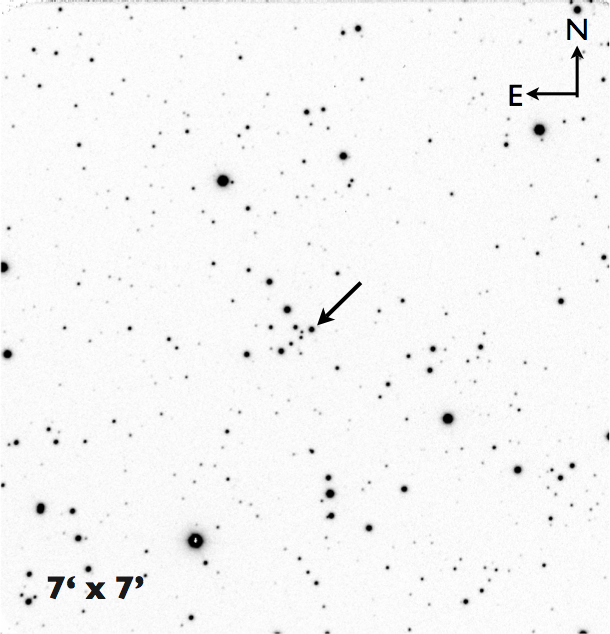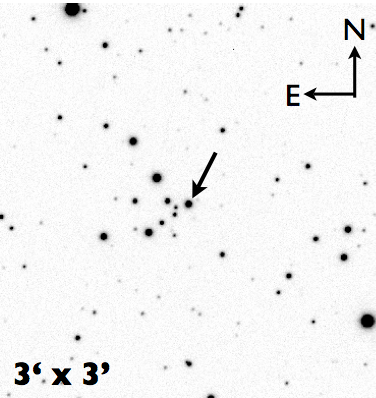P52-032: Monitoring the enigmatic binary V838 Mon
P.I.: Thomas Augusteijn
Co-is: Tiina Liimets, Indrek Kolka (Tartu Observatory, Estonia)
Instructions for the monitoring programme
Background information
This programme is to monitor photometrically and spectroscopically the
peculiar binary system V838 Mon with ALFOSC.
The 2002 outburst of V838 Mon was one the most remarkable stellar
explosions observed in the last decade. In spite of the many studies
presented and a whole conference dedicated to it, our understanding of
the phenomenon is still poor. Since October 2008 the system is in
never before observed deep minima. This service programme is to
monitor the current unusual eclipse-type event to understand its
nature. Understanding the eclipse will also provide basic knowledge
about this remarkable object.
Observing setup: Run A (monitoring)
Observing dates:
10 October 2015
31 March 2016
Instrument: ALFOSC
Total observing time: 1h
Optical elements:
UBVRi
grism #4 + Slit 1.0
grism #17 + Slit Vert_0.5
No weather or seeing restrictions.
Target: V838 Mon 07 04 04.85 -03 50 51.1 ep=2000
Standard star: HD 19445 or HD 84937 (TCS catalogue entry SP0305+261 and SP0946+139, respectively)
Observing setup: Run B (monitoring)
Observing dates: every 2 weeks
23 October 2015
07 November 2015
21 November 2015
04 December 2015
15 December 2015
29 December 2015
10 January 2016
25 January 2016
04 February 2016
17 February 2016
01 March 2016
19 March 2016
Instrument: ALFOSC
Total observing time: 5 min
Optical elements:
BR
No weather or seeing restrictions.
Target: V838 Mon 07 04 04.85 -03 50 51.1 ep=2000
Observing setup: Run C (ToO)
Observing date:
To be decided.
Instrument: ALFOSC
Total observing time: 1h
Optical elements:
UBVRi
grism #4 + Slit 1.0
grism #17 + Slit Vert_0.5
No weather or seeing restrictions.
Target: V838 Mon 07 04 04.85 -03 50 51.1 ep=2000
Standard star: HD 19445 or HD 84937 (TCS catalogue entry SP0305+261 and SP0946+139, respectively)
Visibility plot for today for a target and spectroscopic standard stars.
In the afternoon:
- See general instructions
how to start the observing system.
- Go to the programme directory where all the scripts are located.
In Sequencer window type cd /scripts/52-032/
- Insert the coordinates of the target into the TCS catalogue. In Sequencer window type catalogue
- Read in ALFOSC standard stars catalogue. In the TCS user-interface type read FS.cat
- Make 9 full frame biases and copy them to /data/service/calib/.
Make sure you use the default 200Kpix/sec read out rate.
In Sequencer window type:
resetxy
remsave_on
rempath /data/service/calib
readspeed 200
resetxy
mdark 0 9
remsave_off
- Start the script to make windowed biases for spectroscopy (only
for Run A and C). In Sequencer window type:
spec_bias.script
Takes 3 minutes. Script is making 7 biases windowed in x direction and 7 biases windowed in y direction.
In the twilight
Obtain at least 3 skyflats in all imaging filters:
UBVRi for Run A and C.
BR for Run B.
See instructions in the
Observer's CookBook.
If you do not use ALFOSC script easyflat please copy the flats to /data/service/calib/.
In the night
Photometry: Run A, B and C
Go to the programme directory where all the scripts are located.
In Sequencer window type cd /scripts/52-032/
- Point to the target. In Sequencer window type point_ima.script
- Do imaging, filter by filter. To start the scripts type in Sequencer window:
Run A and C (16 min) :
i.script exposure_time
R.script exposure_time
V.script exposure_time
B.script exposure_time
U.script exposure_time
Run B (5 min):
B.script exposure_time
R.script exposure_time
where the script name is stating clearly what filter is going to be used and exposure_time is the
exposure time in seconds for a given filter:
Table for expected exposure times
| FILTER | Expt. [sec] |
| i | 0.5 |
| R | 2 |
| V | 10 |
| B | 150 |
| U | 500 |
Each script is setting up the optical element, putting proper focus delta
for a given filter and making one science frame. You only have to check
if the peak counts of the target (pointed with an arrow on the finding
chart) are equal or below the nonlinearity limit (see below for instructions). The source may vary unexpectedly
therefore your interraction is highly NEEDED and APPRECIATED! If the target has peak counts more than 350 000 ADU,
please run the script again with the reduced exposure time. Total
observing time for each run is given above.

How to check the peak counts of the star?
To check the peak counts of the star use IRAF command imexam available in Sequencer window.
If DS9 window has not been started earlier type display-start in Sequencer window.
To load the last frame in the
DS9 window type display. Then type imexam. Move the cursor on top of the target on the DS9 window
and type r. This gives a radial profile plot of the target in additional window (irafterm).
From there peak counts can be seen or read from the lower row as a fifth value.
Spectroscopy: Run A and C (40 minutes)
- Spectrum with the grism #4. In Sequencer window type g4.script V838Mon 400
where V838Mon is an object name and 400 is spectrum exposure time in seconds.
Follow instructions given in the Sequencer window.
Script will firstly point to the target with the parallactic angle.
Secondly, script needs your help to place the object on the
slit. See 7 arcminutes finding chart above and 3 arcminutes below. Note that the orientation
of the acquisition images is according to parallactic angle. When the target is on the slit the
script continues on its own until you hear astrowakeup. The script is setting up proper optical elements
(grism #4, slit 1.0), acquiring proper window, making halogen lamp flat, HeNe arc and science frame.
The script takes approximately 11 min.
- Spectrum with the grism #17. In Sequencer window type g17.script V838Mon 500
where V838Mon is an object name and 500 is spectrum exposure time in seconds.
Follow instructions given in the Sequencer window.
Script will firstly point to the target with the parallactic angle.
Secondly, script needs your help to place the
object on the slit. See 7 arcminutes finding chart above and 3 arcminutes below. Note that the orientation
of the acquisition images is according to parallactic angle. When the target is on the slit the
script continues on its own until you hear astrowakeup. The script is setting up proper optical elements
(grism #17, slit Vert_0.5), acquiring proper window, making halogen lamp flat, ThAr arc and science frame.
The script takes approximately 16 min.

- If the night is photometric obtain spectra of standard star with both grisms.
Choose one of the two spectroscopic standard stars (SP0305+261 or SP0946+139) which is
at the similar airmass as the target was observed. Same scripts as for a target are used.
In sequencer window type:
g4.script SP0305+261 1
g17.script SP0305+261 12
or
g4.script SP0946+139 1
g17.script SP0946+139 12
where 1 and 12 are exposure times, SP0305+261 and SP0946+139 object names.
For both standards with grism #4 exposure time is 1 sec
(total observing time approximately 4 minutes) and with grism #17 12 sec (total observing
time approximately 8 minutes). NB! The pointing script expects that the ALFOSC
standard stars catalogue (FS.cat) has been inserted into TCS catalogue.
Spectra scripts need your help to place the object on the slit.
Click here
for finding charts of the standard stars.
If any questions do not hesitate to contact me, day or night.
tiina@obs.ee
+372 56913161
Thank you very much for your cooperation!
Invalid Proposal |


